Chapter 3. Interior Alaska
Day 10 - May 25 - Tetlin National Forest & Tok Cutoff
(Shari) How can it take three hours to go 26 mi.? I wondered that last night
at the travel meeting and I wonder that this morning. But if you know Bert, you
can guess the reason. He sees birds around every corner, so therefore we have to
stop for them. On two occasions, I honk the horn to awaken him to the fact that
time is a fleeting and we have miles to travel and other places to go. We gain
some time in Tok where we hurry to obtain our fishing licenses, wine for
tonight’s party and eat lunch before the last stretch of road to Glennallen. The
sun is out again today but clouds obscure the mountain peaks of Mount Sanford
and Mount Drum. It has been a very long day and we arrive at camp at 4:30 (we
left this morning at 6 and that is 11.5 hr. on the road when you count the time
change). Bert and I always disagree about this leg and he always wins the
argument. I want to stop in Tok and he wants to push on. Good thing we have
attitude readjustment with “Welcome to Alaska” wine and cheese around a
campfire. Bert gives his owl talk but for the first time the Northern Hawk Owl
does not make an appearance when called. Darn, that was such a highlight other
years. I decide to stay home and watch the birders depart at 8 PM for their
nighttime owling expedition. I am asleep before Bert comes home so I do not know
if the trip was successful.
(Bert) Leaving Beaver Creek, our first stop is Mirror Creek. Steve wonders
why we are stopping here, seeing only an empty marsh, but then notices all the
birds and in a half hour we find 33 species from where we stand. Common
Yellowthroats are plentiful, we see and hear our first Fox Sparrow and again
find Rusty Blackbirds. A Bald Eagle incubates on the same nest I saw it two
years ago. We stop for a group photo in front of the large carved wooden sign
announcing we have reached Alaska and the border crossing goes smoothly and
fairly quickly. Refueling on cheaper U.S. gas prices (advertised cheapest in 200
mi.), Shari negotiates an additional discount for the caravan. Still, we pay
$4.519 per gal. for gasoline and $4.979 for diesel, compared to our last trip
when diesel was $2.999/gal. Stopping at Tok Junction for fishing licenses,
supplies and the visitor’s center, I notice the semitrailer next to me has Texas
plates, as we do, and initiate a conversation with the female truck driver. We
took 19 days from the Lower 48 to the Alaska border and I ask her how long she
took. She left Shelby, MT, on Tuesday and delivered her load in Fairbanks on
Friday. Today, Saturday, she is on her way back.
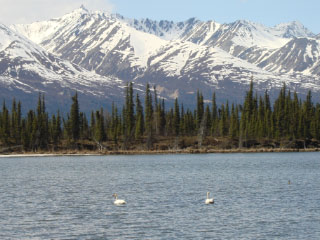 After lunch we continue on the Tok Cutoff, stopping at Slana Slough where I
have often found moose and ducks. They are here again and the birding is better
than ever. A pair of Trumpeter Swans are close enough for good photos and the
backdrop of snow-covered mountains makes for a pretty picture. Most impressive
is the unique experience of seeing three loon species in view at the same time,
including Common Loon, Pacific Loon and two Red-throated Loons.
After lunch we continue on the Tok Cutoff, stopping at Slana Slough where I
have often found moose and ducks. They are here again and the birding is better
than ever. A pair of Trumpeter Swans are close enough for good photos and the
backdrop of snow-covered mountains makes for a pretty picture. Most impressive
is the unique experience of seeing three loon species in view at the same time,
including Common Loon, Pacific Loon and two Red-throated Loons.
Arriving at our campsite near Glennallen, Shari and I get lots of help in
setting up for our “Welcome to Alaska” wine and cheese party. After a long day –
about to become longer – everyone is ready for a party, down to the last drop of
red wine squeezed out of the plastic liner of the 5-liter box. I present my
Great Gray Owl talk, which includes more stories of owl searching then owl
finding. The finale of this talk, which I’ve given several times before, is for
a Northern Hawk Owl to fly into a spruce tree above us when I play its calls on
my iPod. This time my partner does not show up. We later learn from the
campground owner that the local pair of hawk owls has not yet arrived this
spring. Nonetheless, at 8 PM we load three cars of birders anxious to find owls
on a quiet side road near here. However, after over 4 hours of slow driving and
a few stops we find only one owl, a low flying Short-eared Owl. A few other
events entertain us though, including grand distant views of glaciers and white
mountains illuminated by a slowly descending sun. We drive with the windows
down, even though it is 37º outside and the windchill is icy cold, so that I can
listen for birds. At 11:30 PM I hear a familiar sound and ask Chris to stop the
car. I hop out and believe I am hearing Gray-cheeked Thrush. When I play a
recording the thrush responds by flying past us, landing on the opposite side
and continuing its cheery song.
In spite of the near absence of owls on owling night, we certainly continue
our winning streak of mammals with five sightings of Porcupines. In fact, the
mammal list today includes eight other species: 4 Moose, 18 Snowshoe Hares, 2
Red Squirrels, plus Red Fox, Coyote, Muskrat, Bear and Beaver. When we return to
camp, the sun is below the horizon yet there is almost enough light to drive
without headlamps. After a long day of adventure, we barely have the presence of
mind to say goodnight to each other as we climb into our RV’s at 12:30 AM.
Day 11 - May 26 - Glennallen
(Bert) Everyone sleeps in this morning, including me. Our first scheduled
event is at 3 PM, which begins with a birding walk around our campsite. Since
some have not yet seen Common Redpolls we search for them and find one at the
same time we coax a singing Olive-sided Flycatcher to come closer in view. Then
we drive the short distance to Ryan Lake. Only a fraction of a mile from our
campsite I yell over the personal radio, “Hawk Owl on the left on top a tall
spruce”. Brakes slam, birders exit as if the vehicles were on fire, everyone
rushes outside to see the perched owl. It ignores us as it also ignores the
Rusty Blackbird that repeatedly dive bombs the owl, unhappy with its presence so
near its nesting territory. High fives and excitement abound and I feel redeemed
from last night’s dearth of owls. At Ryan Lake we get another look at
Red-throated Loons. These are so distant across the lake that we need a short
workshop in loon identification to end the debate of which species it is. I
emphasize body, head and bill shape as a more valuable identification mark than
coloring.
Back at the campground lodge I conduct a bird count off that covers the past
three days. Our travels through Canada brought us 130 bird species, with 101 in
British Columbia and 93 in Yukon Territory. Two years ago our total was 136
species. In mammal species we beat 2006. This year we saw 21 species in Canada.
Day 12 - May 27 - Glenn Highway
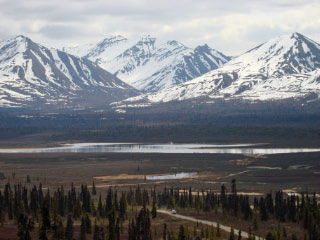 (Shari) Eating reindeer sausage with eggs and toast on log tables inside the
windowed dining room is a wonderful way to start the day. We do not depart until
11:00 and only have 104 mi. to travel, stopping twice before we reach Palmer.
Most of us have had our mail sent to the Palmer post office for our pick up.
While Bert retrieves our mail, I shop for groceries at Fred Meyer, one of my
favorite stores. Later we all enjoy the view from the RV Park while Bert talks
about the differences between the three ptarmigans. The weather is just perfect
and the snow-capped mountainous view on the bluff is fantastic. Bill, Ginny,
Curt, Chris, Bert and I don’t want the day to end and sit awhile longer after
our meeting to soak in the scene. I don’t go inside until I get cold but Bert
does not follow for quite some time. It has been a good day
(Shari) Eating reindeer sausage with eggs and toast on log tables inside the
windowed dining room is a wonderful way to start the day. We do not depart until
11:00 and only have 104 mi. to travel, stopping twice before we reach Palmer.
Most of us have had our mail sent to the Palmer post office for our pick up.
While Bert retrieves our mail, I shop for groceries at Fred Meyer, one of my
favorite stores. Later we all enjoy the view from the RV Park while Bert talks
about the differences between the three ptarmigans. The weather is just perfect
and the snow-capped mountainous view on the bluff is fantastic. Bill, Ginny,
Curt, Chris, Bert and I don’t want the day to end and sit awhile longer after
our meeting to soak in the scene. I don’t go inside until I get cold but Bert
does not follow for quite some time. It has been a good day
(Bert) The few that were not with us when we saw the Northern Hawk Owl
yesterday get their chance today. Earlier, Joann with some help from others
relocated the same owl at the same place and when we drive past now with our
RV’s it is still there. Thirteen miles farther on the Glenn Highway I see
another on a tall spruce beside the road and now Curtis gets his life bird.
Today’s scenery along the Glenn Highway is a panorama of postcards, each view
another stunning image of broad valleys leading up to the snow covered Chugach
Mountains. When we climb through the pass the view shortens, but the height is
accentuated. At the higher elevations the aspen are still in bud and as we
descend into the Matanuska Valley the leaves come out until fully grown by the
time we reach Palmer. It is like a time lapse movie of spring that shrinks two
weeks into two hours. The highway is much improved: wider, smoother, straighter.
We hit the construction zone where we still have a taste of the old highway, but
in another year that will be improved as well.
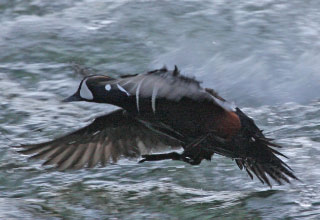 Day 13 - May 28 - Hatcher Pass
Day 13 - May 28 - Hatcher Pass
(Bert) The pair of Harlequin Ducks whizz past us, heading downstream, and
crash land in the fast moving Little Susitna River. The brightly patterned drake
continues its pursuit of the drab hen. She resists and the two splash through
the waves, up and down in the churning water and chasing around the boulders.
Then they are off again, heading farther downstream and out of sight.
At our next stop on the canyon road heading to Hatcher Pass we set up the
spotting scopes to scan the mountainsides. Bill is the first to spot a white dot
between the large patches of remnant snow on the short stubble alpine slopes.
Even with the scopes on the white dot we wonder at first if it is animate or
inanimate. When it moves a few observers think they see black on the tail or
black near the bill and eye, but the distance is so great we are not sure. Just
then another ptarmigan flies over the first and I can clearly see the black tail
edges marking this as a Rock Ptarmigan (a White-tailed is all white in winter
and a Willow is not expected in the alpine habitat nor is it likely to be still
in winter plumage). A lady who introduces herself as Charlie starts talking to
Shari and knew our group would be birding here, having learned of us from her
friends – and ours - Kathy and Rick. Apparently we missed our rendezvous point
and Shari calls Kathy, my grade school and our high school classmate, on the
cell phone. Soon they join us while we are still watching the Rock Ptarmigans.
We continue uphill to another location and stop again at higher elevation. We
again find Rock Ptarmigans, but now with closer view we are able to see the
black line connecting eye to bill. Mel was reluctant to include his view of the
first ptarmigan to his life list, but this one is convincing and is a memorable
500th life bird for Mel. Bill and I head uphill when we hear a Willow Ptarmigan
and try to zero in on the clucking sound. Bill finds a Hoary Marmot resting on
an enormous boulder and when I call on the radio to the others farther downhill
they align their scopes on the boulder. Shari radios back that they see the male
Willow Ptarmigan resting in a short willow shrub hedge behind the boulder.
Continuing uphill we reach the restaurant where we will eat lunch later, but
now continue on foot toward the old mining operation. The terrain is subalpine
and alpine with lots of snow still covering the ground. Arctic Ground Squirrels
scamper across the snow on all fours, with short tails pointing perpendicularly
above them. Farther below we saw and heard Lincoln, Fox and Golden-crowned
sparrows, but here it is White-crowned and Savannah sparrows that are
everywhere. In spite of the frigid looking terrain, the air is warm and the
skies clear, giving us a stunning long distance view of the mountains and the
valley below.
(Shari) We enjoy another day of perfect weather; crystal clear air, beautiful
sunshine in a cloudless sky enhances our day exploring Hatcher Pass. Kathy, a
high school classmate, and her husband Rick join our group on its outing. We see
Harlequin Ducks at the lower elevation, ptarmigans at tree level and more drop
dead gorgeous scenery at the top. Marlene does a little shuffle when she sees a
ptarmigan for the first time. Everyone gets good looks at the Willow and Rock
ptarmigans and are treated with the cluck cluck of the bird attracting a mate.
The road to the mine is not covered with snow this year so I walk to the top. As
I turn around, I have to catch my breath at the scene. I feel so small
surrounded by mountains glistening with snow like frosting on a cake. When we
get to the lodge at the pass we stop for lunch and Bert and I share a salmon
burger and yummy raspberry-blackberry pie ala mode. On our way down the pass we
get picture perfect views of the clown-like harlequin pair in a glassy pond.
Kathy and Rick join us for our grill meat potluck where everyone brings their
own meat to grill and a side dish to share. Kathy made German potato salad
prepared with potatoes from her garden and fiddlehead ferns she picked from her
yard. All is good, but the best is when Marie brings “sex in a pan”, a
concoction of chocolate pudding and cool whip on a nut crust. Our own ‘Ukulele
Bill” serenades us with song until the mosquitoes drive us indoors.
Day 14 - May 29 - Anchorage
(Bert) Shari and I leave Palmer hours before the others so that we can tow
our disabled SUV to the mechanic. At the shop I’m concerned about where to park
so that we can get the car off and push it into the bay, but the mechanic said
we can drive it in. I look at him quizzically and he asks, “You have 4-wheel
drive don’t you?” So he shifts into 4-WD and backs the car away from R-Tent-III.
It had not occurred to me that we didn’t need a drive shaft to do that and it is
now being propelled by the front wheels only. Besides, I thought with all the
missing parts such an action could do damage. No problem! With the car up on the
rack he inspects the underside and tells us the bearing failed on the rear part
of the drive shaft which allowed the long and heavy portion of the shaft to
break free, forcing the front connection to break apart. Apparently the lost
components are the Remco parts and none of the Nissan parts are missing, with
only scratches and small dents in the gas tank as the shaft bounced around. The
mechanic will order a complete new Remco disconnect, have it shipped 2-day air
to Anchorage and have the job completed sometime next week. It will cost us
about $1350, none covered by warranty which expired 5 yr. ago and since we
installed the Remco the day we bought the car, it has been driven almost 54,000
mi. and towed at least as many miles more.
(Shari) “If this is a rated a difficulty 2, I’d hate to see a 3”, I tell
Steve and Nancy as we walk away from the geocaching site without finding the
cache. After our meeting this evening they told me a cache was hidden within
walking distance. Off we go to find our treasure. Steve lets “May” and me take
the lead and I find the spot within the accuracy of the GPS, plus or minus 16
ft. Now we search, and we search and we search. The hints given tell us “not to
worry about the snow” and “bend but not break” and “to think outside the box”.
We search. We bend. I think I might break. We look up. We look down. Still no
cache! After about 45 min. we give up and return to camp for Steve and Nancy to
look for more clues on the Internet and me to rejoin the party going on in front
of Chris and Curt’s rig. No sooner does Bert retrieve my chair from R-Tent-III
than Steve and Nancy say they are going to drive back to the site. Off we go
again with more clues. It can be seen from the street and one “finder” thought
it might flip off. Now we think it just has to be up high. We look all around
again pulling and bending saplings, looking under leaves and under branches,
crossing the street and looking back. No cache! All of a sudden Nancy yells, “I
found it”. As soon as I turn around I see where she is standing and the cache is
so obvious I wonder how we missed it for so many minutes. I cannot NOT see it
now. It is a white tube hanging by a white rope from a small sapling on an open
path. How stupid can we be to have missed it, I wonder? The important thing
though is now we can go back successful and not with our tail behind our legs.
Too bad everyone has left the party when we return. I can only share my success
with Bert, who has to listen.
Day 15 - May 30 - Anchorage
(Bert) Anchorage has a wonderful park system and today we visit two of the
parks as well as the Tony Knowles Coastal Trail which connects them and
continues along the shore of the Knik Arm of Cook Inlet. At Kincaid Park, an
expansive boreal forest crisscrossed with wide cross country ski trails, we are
barely on the trail system when we encounter a moose directly in front of us. We
freeze and watch the moose meander along the forest edge, browsing on the fresh
stems of aspen branches. Although sparse on birds, the forest hike is pleasant
and we look up to a Yellow-rumped Warbler sitting on a nest in the cleft of a
tree and look down across an expansive woods where Bill spots a Bald Eagle
sitting on a treetop nest with the inlet and the ridge of snow covered mountains
as a backdrop. Swainson’s Thrushes are common and it seems every third bird is
one. We must have hiked three miles before we return to the parking lot, so
everyone is ready to eat the lunches they packed.
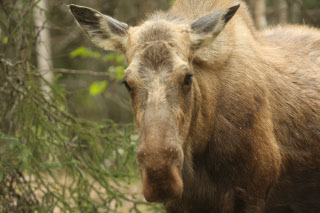 Next we drive around the airport to Earthquake Park where a series of
signposts tell us about the devastating 1964 earthquake that rocked Alaska. We
walk along the coastal trail and scan the almost empty mudflats. We see a lone
Sandhill Crane walk gracefully across the broad flats, its striking rusty red
plumage a stark contrast to the dull gray mud. On the walk back we encounter
another moose and this one we must call a close encounter. We step to the edge
of the blacktop path and wait quietly while the moose lumbers slowly past us on
the opposite side, less than 12 ft. from us. That distance is not much more than
one body length for the moose.
Next we drive around the airport to Earthquake Park where a series of
signposts tell us about the devastating 1964 earthquake that rocked Alaska. We
walk along the coastal trail and scan the almost empty mudflats. We see a lone
Sandhill Crane walk gracefully across the broad flats, its striking rusty red
plumage a stark contrast to the dull gray mud. On the walk back we encounter
another moose and this one we must call a close encounter. We step to the edge
of the blacktop path and wait quietly while the moose lumbers slowly past us on
the opposite side, less than 12 ft. from us. That distance is not much more than
one body length for the moose.
We make one last stop, at Lake Hood where the float planes use the water as a
runway and the ducks and swallows almost ignore the passing planes. So many
ducks are on the water that we get some interesting comparisons: Barrow’s
Goldeneyes floating beside Common Goldeneyes, side by side Redhead and
Canvasback, and best of all is a pair of Greater Scaup swimming in a line behind
a pair of Lesser Scaup  . Just last night I gave a talk on identifying these two
very similar species and I could not have asked for a better workshop lesson
then the one before us now.
. Just last night I gave a talk on identifying these two
very similar species and I could not have asked for a better workshop lesson
then the one before us now.
Day 16 - May 31 - Anchorage
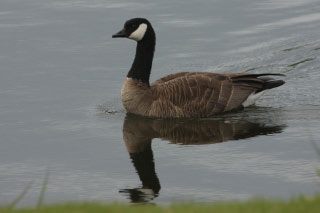 (Bert) Bill reports a Glaucous-winged Gull as soon as we arrive at
Westchester Lagoon, but it takes a long time before we can relocate one for the
rest of us to see. Black wing-tipped Mew Gulls and Herring Gulls are plentiful
and then I see a few gulls with dark gray wing tips, a cross between Herring and
Glaucous-winged. Finally we see a pure Glaucous-winged Gull in flight, where the
wing tips match the wing color and ending a illustrative study in gulls. On the
edge of the small island Steve finds a small flock of Hudsonian Godwits, the
last remaining migrants that must have been here in much larger numbers before
we reached Alaska. Having just finished the gull study and now approaching the
second island, I ask the group if the geese there are Canada or Cackling. Scopes
line up and field guides open to the goose page. It doesn’t take long before
most deduce they are Cackling Geese and several attempt to identify the
subspecies.
(Bert) Bill reports a Glaucous-winged Gull as soon as we arrive at
Westchester Lagoon, but it takes a long time before we can relocate one for the
rest of us to see. Black wing-tipped Mew Gulls and Herring Gulls are plentiful
and then I see a few gulls with dark gray wing tips, a cross between Herring and
Glaucous-winged. Finally we see a pure Glaucous-winged Gull in flight, where the
wing tips match the wing color and ending a illustrative study in gulls. On the
edge of the small island Steve finds a small flock of Hudsonian Godwits, the
last remaining migrants that must have been here in much larger numbers before
we reached Alaska. Having just finished the gull study and now approaching the
second island, I ask the group if the geese there are Canada or Cackling. Scopes
line up and field guides open to the goose page. It doesn’t take long before
most deduce they are Cackling Geese and several attempt to identify the
subspecies.
(Shari) The weather is perfect. The habitat is just right and varied. It
should be a good day to go out and look. This is the kind of birding I like. I
look for earrings with birds on them. I see blouses and/or T-shirts with puffins
or eagles. Bird carvings out of ivory abound. Hats, wooden boxes, jewelry,
paintings and framed photographs, all are adorned with birds, birds, and more
birds. Carol, Ginny, Marlene, Bill and I all go early to the Anchorage Saturday
Market. The rest of the birders are to join us at 11 AM after their outing. Up
and down the aisle we go looking at all the wares for sale from different
vendors. I just barely finish my shopping before I have to meet the whole group.
We walk to the restaurant for a nice soup and sandwich lunch. After lunch, while
Bert pays our bill, Steve, Nancy and I walk about 400 ft. to locate another
geocache. “May” leads me straight to it and Nancy finds it right away. I am a
little misled when the clue says someone in a wheelchair could get it. No way is
that possible unless the wheelchair was 10 ft. high. Bert has not even paid yet
when we successful “hunters” return. Carol, Ginny and I continue our shopping
downtown, spending most of our time in one store. I buy more Christmas presents
and think I win the prize for most money spent. I ran out of cash (much to
Bert’s dismay) earlier so luckily the stores accept plastic.
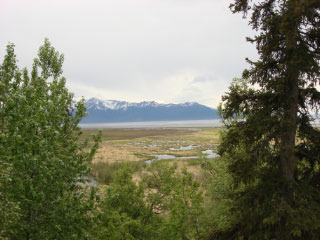
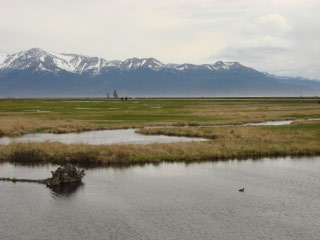
Day 17 - June 1 - Anchorage
(Shari) We are all set to go to church when I suddenly realize that we do not
have a car. So, we borrow Jim and Donna’s and go to a Lutheran church not far
from our camp. It has a peppy service and friendly congregation and the female
vicar gives a nice sermon on faith. After lunch I go along on the birding outing
only because I know of two caches in the area. You can imagine how disappointed
I am that Potter Marsh has a sign on it that says “Closed for Construction”. I
vote to park at the barricade and walk in anyway. I whine when Steve and Nancy
stop to bird because “May” seems to have lost her battery power and I need
Steve’s GPS. He follows me and we walk almost to the end of the boardwalk before
we reach the coordinates. As one of the clues mentions, searching on our hands
and knees and looking under the bench we must look strange from a passerby on
the highway. But I find the 2 in. round container and after some trouble opening
it, we sign our names. I leave the birders and walk back to the cars. I notice
that I am very close to another cache and I begin to look for it. Carol, Marlene
and Bill also help me search. I FIND IT ALL BY MYSELF. I sign my name on the log
and put the container back for Steve or Nancy to find. I like this geocaching.
Unlike birds, at least the cache stays stationary until I have a chance to
locate it.
(Bert) Potter Marsh is often mentioned as one of the best birding spots in
the Anchorage area. We first head to the mountainside overlooking the marsh and
stop where I remember seeing a Bald Eagle nest four years ago. I see the narrow
path through the woods and 75 ft. along the path takes us to an eye-level view
of an adult and one nestling on the nest. The nest is in a different location
than I remember, but still close-by. The marsh itself seems less active than
prior years, yet we find 10 waterfowl species and nesting Mew Gulls, Arctic
Terns and a Hairy Woodpecker feeding young through a tree hole.
 Next
Day
Next
Day  Table
of Contents
Table
of Contents
 After lunch we continue on the Tok Cutoff, stopping at Slana Slough where I
have often found moose and ducks. They are here again and the birding is better
than ever. A pair of Trumpeter Swans are close enough for good photos and the
backdrop of snow-covered mountains makes for a pretty picture. Most impressive
is the unique experience of seeing three loon species in view at the same time,
including Common Loon, Pacific Loon and two Red-throated Loons.
After lunch we continue on the Tok Cutoff, stopping at Slana Slough where I
have often found moose and ducks. They are here again and the birding is better
than ever. A pair of Trumpeter Swans are close enough for good photos and the
backdrop of snow-covered mountains makes for a pretty picture. Most impressive
is the unique experience of seeing three loon species in view at the same time,
including Common Loon, Pacific Loon and two Red-throated Loons.  (Shari) Eating reindeer sausage with eggs and toast on log tables inside the
windowed dining room is a wonderful way to start the day. We do not depart until
11:00 and only have 104 mi. to travel, stopping twice before we reach Palmer.
Most of us have had our mail sent to the Palmer post office for our pick up.
While Bert retrieves our mail, I shop for groceries at Fred Meyer, one of my
favorite stores. Later we all enjoy the view from the RV Park while Bert talks
about the differences between the three ptarmigans. The weather is just perfect
and the snow-capped mountainous view on the bluff is fantastic. Bill, Ginny,
Curt, Chris, Bert and I don’t want the day to end and sit awhile longer after
our meeting to soak in the scene. I don’t go inside until I get cold but Bert
does not follow for quite some time. It has been a good day
(Shari) Eating reindeer sausage with eggs and toast on log tables inside the
windowed dining room is a wonderful way to start the day. We do not depart until
11:00 and only have 104 mi. to travel, stopping twice before we reach Palmer.
Most of us have had our mail sent to the Palmer post office for our pick up.
While Bert retrieves our mail, I shop for groceries at Fred Meyer, one of my
favorite stores. Later we all enjoy the view from the RV Park while Bert talks
about the differences between the three ptarmigans. The weather is just perfect
and the snow-capped mountainous view on the bluff is fantastic. Bill, Ginny,
Curt, Chris, Bert and I don’t want the day to end and sit awhile longer after
our meeting to soak in the scene. I don’t go inside until I get cold but Bert
does not follow for quite some time. It has been a good day  Day 13 - May 28 - Hatcher Pass
Day 13 - May 28 - Hatcher Pass
 Next we drive around the airport to Earthquake Park where a series of
signposts tell us about the devastating 1964 earthquake that rocked Alaska. We
walk along the coastal trail and scan the almost empty mudflats. We see a lone
Sandhill Crane walk gracefully across the broad flats, its striking rusty red
plumage a stark contrast to the dull gray mud. On the walk back we encounter
another moose and this one we must call a close encounter. We step to the edge
of the blacktop path and wait quietly while the moose lumbers slowly past us on
the opposite side, less than 12 ft. from us. That distance is not much more than
one body length for the moose.
Next we drive around the airport to Earthquake Park where a series of
signposts tell us about the devastating 1964 earthquake that rocked Alaska. We
walk along the coastal trail and scan the almost empty mudflats. We see a lone
Sandhill Crane walk gracefully across the broad flats, its striking rusty red
plumage a stark contrast to the dull gray mud. On the walk back we encounter
another moose and this one we must call a close encounter. We step to the edge
of the blacktop path and wait quietly while the moose lumbers slowly past us on
the opposite side, less than 12 ft. from us. That distance is not much more than
one body length for the moose.  (Bert) Bill reports a Glaucous-winged Gull as soon as we arrive at
Westchester Lagoon, but it takes a long time before we can relocate one for the
rest of us to see. Black wing-tipped Mew Gulls and Herring Gulls are plentiful
and then I see a few gulls with dark gray wing tips, a cross between Herring and
Glaucous-winged. Finally we see a pure Glaucous-winged Gull in flight, where the
wing tips match the wing color and ending a illustrative study in gulls. On the
edge of the small island Steve finds a small flock of Hudsonian Godwits, the
last remaining migrants that must have been here in much larger numbers before
we reached Alaska. Having just finished the gull study and now approaching the
second island, I ask the group if the geese there are Canada or Cackling. Scopes
line up and field guides open to the goose page. It doesn’t take long before
most deduce they are Cackling Geese and several attempt to identify the
subspecies.
(Bert) Bill reports a Glaucous-winged Gull as soon as we arrive at
Westchester Lagoon, but it takes a long time before we can relocate one for the
rest of us to see. Black wing-tipped Mew Gulls and Herring Gulls are plentiful
and then I see a few gulls with dark gray wing tips, a cross between Herring and
Glaucous-winged. Finally we see a pure Glaucous-winged Gull in flight, where the
wing tips match the wing color and ending a illustrative study in gulls. On the
edge of the small island Steve finds a small flock of Hudsonian Godwits, the
last remaining migrants that must have been here in much larger numbers before
we reached Alaska. Having just finished the gull study and now approaching the
second island, I ask the group if the geese there are Canada or Cackling. Scopes
line up and field guides open to the goose page. It doesn’t take long before
most deduce they are Cackling Geese and several attempt to identify the
subspecies. 
